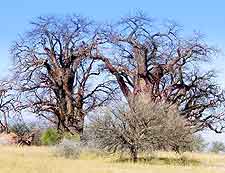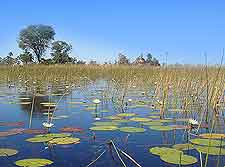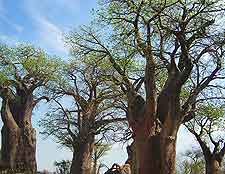Botswana History Facts and Timeline
(Botswana, BW, Southern Africa)

Nowadays, Botswana is best-known among tourists for its national parks and wildlife, yet it also has a rich colonial history. Formerly known as Bechuanaland, it was once a British protectorate and eventually gained independence.
There are several sites across the land that will appeal to those interested in ancient Botswana history. Visitors looking for prehistoric rock art can visit sites such as the Tsodilo Hills, while the D'Kar and Xai Xai villages both feature regular exhibitions of tribal rituals.
Bechuanaland
Despite inhabitation for many years previously, the more fascinating history of Botswana begins in the late-19th century, a time when skirmishes began to break out between the Shona tribes of Botswana and the incoming Ndebele. The Ndebele, an offshoot of the Zulus, migrated here across the Kalahari Desert, now home to one of the world's best-known game reserves and a popular tourist destination in its own right.
The Kalahari is still home to around 10,000 hunter-gatherers known as the San, living the same way that their ancestors did thousands of years before. Since the middle of the 1990s, the country's government has attempted to remove the San, attracting criticism from the international community and leaving a black mark against the history of Botswana.
Disputes with the Transvaal Boers in the late-1800s led Botswana's leaders to appeal for help from the British. The British established the Bechuanaland Protectorate in the year of 1885, administering the northern territories until 1964. The southern part of the protectorate, known as the Cape Colony, was handed over to the Union of South Africa in 1910. There was an intention to eventually hand over the northern territories to
South Africa too, but the 1948 implementation of apartheid in South Africa soon halted that notion.
The main legacy of colonial rule that tourists will encounter is that English is the official language spoken here. Everyone in the capital, Gaborone, will speak English, while those visiting other destinations may encounter Setswana, the principal indigenous language.

Independence
After several decades in which the evolution of tribal government was actively encouraged by the British, a proposal for self-government was eventually accepted in June 1964. This led to the government seat in Mafikeng, South Africa, moving to Botswana's new capital, Gaborone, in 1965. After the first elections in that year, Seretse Khama became the president and oversaw the transition to an independent Botswana in 1966. His son, Ian Khama, was elected as president in April 2008.

Political History and the Military
Since independence, the political landscape has been dominated by the Botswana Democratic Party (BDP), whose public institutions are said to be most secretive. However, this still ranks as the least corrupt country on the continent. It has not suffered civil war or economic collapse like other neighbours, such as
Namibia, Zambia and Zimbabwe.
Before independence, Botswana was one of Africa's most peaceful countries and did not even have its own armed forces. However, attacks by South African and Rhodesian troops led to the formation of the Botswana Defence Force (BDF) in 1977.
Nowadays, the US-funded BDF is more involved in disaster-preparation and peacekeeping operations. Mostly however, Botswana is a low-key country that has little fertile land, although it does boast vast mineral resources, especially diamonds, as well as a government that manages its national wealth wisely. Perhaps its biggest claim to fame in recent years is its setting for the best-selling novel series from Alexander McCall Smith, 'The No. 1 Ladies Detective Agency'.
 Nowadays, Botswana is best-known among tourists for its national parks and wildlife, yet it also has a rich colonial history. Formerly known as Bechuanaland, it was once a British protectorate and eventually gained independence.
Nowadays, Botswana is best-known among tourists for its national parks and wildlife, yet it also has a rich colonial history. Formerly known as Bechuanaland, it was once a British protectorate and eventually gained independence.
